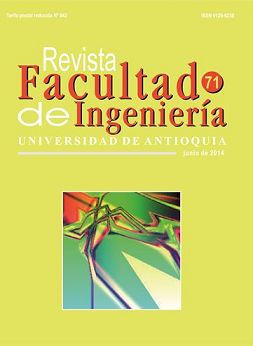Molecular states of laterally coupled quantum dots under electric fields
DOI:
https://doi.org/10.17533/udea.redin.15984Keywords:
artificial molecule, two laterally coupled quantum dots, one electron energy spectrum, molecular states, wavelength-tunable single-photon emitterAbstract
The states of a single electron trapped in two laterally coupled quantum dots are studied theoretically in the framework of the effective mass and envelope function approximations. The electron tunneling between dots is studied by varying of inter-dot distance and we showed that the lateral quantum coupling between them allows the formation of molecular-like states, which exhibit similar characteristics to those of a molecule H2+. The effect of an in-plane electric field on the energy spectrum is analyzed and our results reveal that the wavelength of photons emitted from the system can be tuned by simply applying a low-intensity electric field. This latter feature is consistent with experimental observations.
Downloads
References
K. Brunner, U. Bockelmann, G. Abstreiter, M. Walther, G. Böhm, G. Tränkle, G. Weimann. “Photoluminescence From a Single GaAs/AlGaAs Quantum Dot”. Physical Review Letters. Vol. 69. 1992. pp. 3216-3219. DOI: https://doi.org/10.1103/PhysRevLett.69.3216
J. Marzin, J. Gérard, A. Izraël, D. Barrier, G. Bastard. “Photoluminescence of Single InAs Quantum Dots Obtained by Self-Organized Growth on GaAs”. Physical Review Letters. Vol. 73. 1994. pp. 716-719. DOI: https://doi.org/10.1103/PhysRevLett.73.716
R. Ashoori. “Electrons in Artificial Atoms”. Nature. Vol. 379. 1996. pp. 413-419. DOI: https://doi.org/10.1038/379413a0
L. Kouwenhoven. “Coupled Quantum Dots as Artificial Molecules”. Science. Vol. 268. 1995. pp. 1440. DOI: https://doi.org/10.1126/science.268.5216.1440
G. Schedelbeck, W. Wegscheider, M. Bichler, G. Abstreiter. “Coupled Quantum Dots Fabricated by Cleaved Edge Overgrowth: From Artificial Atoms to Molecules”. Science. Vol. 278. 1997. pp. 1792-1795. DOI: https://doi.org/10.1126/science.278.5344.1792
M. Pioro, M. Abolfath, P. Zawadzki, J. Lapointe, S. Studenikin, A. Sachrajda, P. Hawrylak. “Charge Sensing of an Artificial H2+ Molecule in Lateral Quantum Dots”. Physical Review B. Vol.72. 2005. pp. 1-5.
M. Korkusinski, P. Hawrylak. “Electronic Structure of Vertically Stacked Self-assembled Quantum Disks”. Physical Review B. Vol. 63. 2001. pp. 1-7. DOI: https://doi.org/10.1103/PhysRevB.63.195311
L. He, G. Bester, A. Zunger. “Electronic asymmetry in Self-assembled Quantum dot Molecules Made of Identical InAs/GaAs Quantum Dots”. Physical Review B. Vol.72. 2005. pp. 1-7. DOI: https://doi.org/10.1103/PhysRevB.72.195307
W. Gutiérrez, J. Marin, I. Mikhailov. “Charge Transfer Magnetoexciton Formation at Vertically Coupled Quantum Dots”. Nanoscale Research Letters. Vol. 7. 2012. pp. 585. DOI: https://doi.org/10.1186/1556-276X-7-585
I. Mikhailov, L. García, J. Marín. “Vertically Coupled Quantum Dots Charged by Exciton”. Microelectronics Journal. Vol. 39. 2008. pp. 378-382. DOI: https://doi.org/10.1016/j.mejo.2007.07.046
J. Planelles, J. Climente, F. Rajadell, M. Doty, A Bracker, D. Gammon. “Effect of Strain and Variable Mass on the Formation of Antibonding Hole Ground States in InAs Quantum Dot Molecules”. Physical Review B. Vol. 82. 2010. pp. 1-8. DOI: https://doi.org/10.1103/PhysRevB.82.155307
E. Muñoz, Z. Barticevic, M. Pacheco. “Electronic Spectrum of Two Coupled Semiconductor Quantum Disks Under External Fields”. Microelectronics Journal. Vol. 34. 2003. pp. 733-736. DOI: https://doi.org/10.1016/S0026-2692(03)00114-9
P. Stano, J. Fabian. “Spin-orbit Effects in Single-electron States in Coupled Quantum Dots”. Physical Review B. Vol. 72. 2005. pp. 1-14. DOI: https://doi.org/10.1103/PhysRevB.72.155410
M. Raith, P. Stano, J. Fabian. “Theory of Single Electron Spin Relaxation in Si/SiGe Lateral Coupled Quantum Dots”. Physical Review B. Vol. 83. 2011. pp. 1-9. DOI: https://doi.org/10.1103/PhysRevB.83.195318
J. Climente, J. Planelles. “Characteristic Molecular Properties of One-electron Double Quantum Rings Under Magnetic Fields”. Journal of Physics: Condensed Matter. Vol. 20. 2008. pp. 1-8. DOI: https://doi.org/10.1088/0953-8984/20/03/035212
D. Bouwmeester, A. Ekert, A. Zeilinger. The Physics of Quantum Information. 1st ed. Ed. Springer. Berlin, Germany. 2000. pp. 133-175. DOI: https://doi.org/10.1007/978-3-662-04209-0
M. Califano, P. Harrison. “Presentation and Experimental Validation of a Single-band, Constant-Potential Model for Self-assembled InAs/GaAs quantum dots”. Physical Review B. Vol. 61. 2001. pp. 10959-10965. DOI: https://doi.org/10.1103/PhysRevB.61.10959
L. Landau, E. Lifshitz. Quantum Mechanics, Non-Relativistic Theory. 3rd ed. Ed. Pergamon Press. Oxford, England. 1977. pp. 302-305.
G. Beirne, C. Hermannstädter, L. Wang, A. Rastelli, O. Schmidt, P. Michler. “Quantum Light Emission of Two Lateral Tunnel-coupled (In,Ga)As/GaAs Quantum Dot controlled by a Tunable Static Electric Field”. Physical Review Letters. Vol. 96. 2006. pp. 1-4. DOI: https://doi.org/10.1103/PhysRevLett.96.137401
Downloads
Published
How to Cite
Issue
Section
License
Copyright (c) 2018 Revista Facultad de Ingeniería

This work is licensed under a Creative Commons Attribution-NonCommercial-ShareAlike 4.0 International License.
Revista Facultad de Ingeniería, Universidad de Antioquia is licensed under the Creative Commons Attribution BY-NC-SA 4.0 license. https://creativecommons.org/licenses/by-nc-sa/4.0/deed.en
You are free to:
Share — copy and redistribute the material in any medium or format
Adapt — remix, transform, and build upon the material
Under the following terms:
Attribution — You must give appropriate credit, provide a link to the license, and indicate if changes were made. You may do so in any reasonable manner, but not in any way that suggests the licensor endorses you or your use.
NonCommercial — You may not use the material for commercial purposes.
ShareAlike — If you remix, transform, or build upon the material, you must distribute your contributions under the same license as the original.
The material published in the journal can be distributed, copied and exhibited by third parties if the respective credits are given to the journal. No commercial benefit can be obtained and derivative works must be under the same license terms as the original work.










 Twitter
Twitter